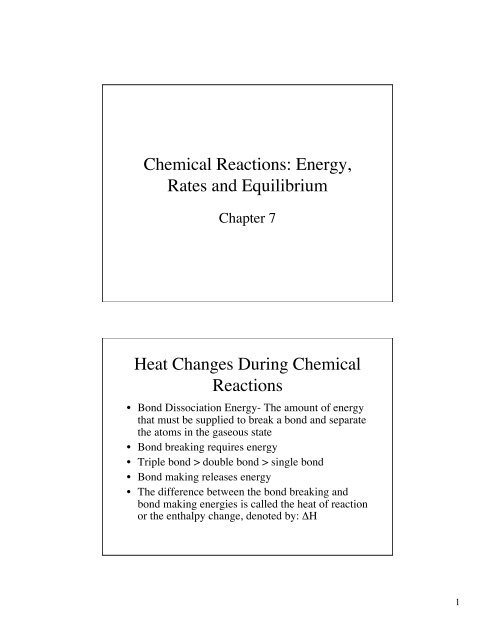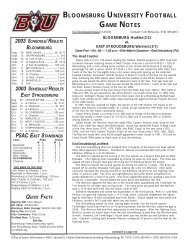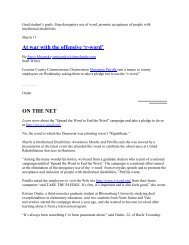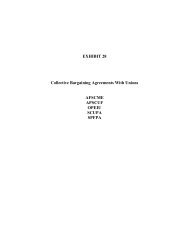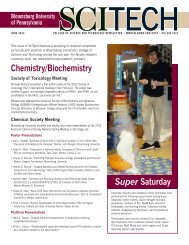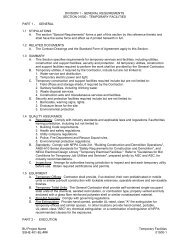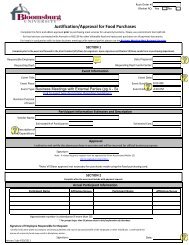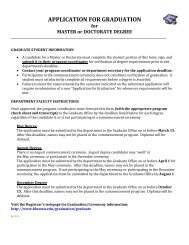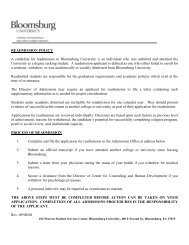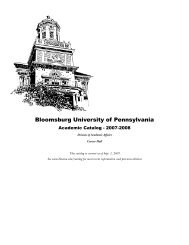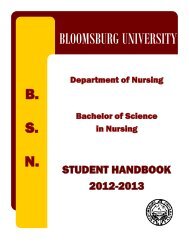Chemical Reactions: Energy, Rates and Equilibrium Heat Changes ...
Chemical Reactions: Energy, Rates and Equilibrium Heat Changes ...
Chemical Reactions: Energy, Rates and Equilibrium Heat Changes ...
You also want an ePaper? Increase the reach of your titles
YUMPU automatically turns print PDFs into web optimized ePapers that Google loves.
<strong>Chemical</strong> <strong>Reactions</strong>: <strong>Energy</strong>,<br />
<strong>Rates</strong> <strong>and</strong> <strong>Equilibrium</strong><br />
Chapter 7<br />
<strong>Heat</strong> <strong>Changes</strong> During <strong>Chemical</strong><br />
<strong>Reactions</strong><br />
• Bond Dissociation <strong>Energy</strong>- The amount of energy<br />
that must be supplied to break a bond <strong>and</strong> separate<br />
the atoms in the gaseous state<br />
• Bond breaking requires energy<br />
• Triple bond > double bond > single bond<br />
• Bond making releases energy<br />
• The difference between the bond breaking <strong>and</strong><br />
bond making energies is called the heat of reaction<br />
or the enthalpy change, denoted by: ΔH<br />
1
Exothermic <strong>and</strong> Endothermic <strong>Reactions</strong><br />
• Exothermic Reaction - A chemical reaction in which<br />
energy is released as the reaction occurs<br />
– The products have lower energy than the reactants<br />
– The chemical bonds that are broken in the reactants are weaker<br />
than the chemical bonds that are formed in the products<br />
• Endothermic Reaction - A chemical reaction in which<br />
energy must be supplied overall to get the reaction to occur<br />
– The products have a higher energy than the reactants<br />
– The chemical bonds that are broken in the reactants are stronger<br />
than the chemical bonds that are formed in the products<br />
Examples of Exothermic <strong>and</strong><br />
Endothermic <strong>Reactions</strong><br />
• Exothermic: ΔH is a negative value<br />
• Endothermic: ΔH is a positive value<br />
2
Why <strong>Chemical</strong> <strong>Reactions</strong> Occur?<br />
• Two factors determine if a process proceeds on its<br />
own without any external influence<br />
– Enthalpy, ΔH<br />
– Entropy, ΔS<br />
• Entropy: A measure of the amount of disorder or<br />
r<strong>and</strong>omness in a system<br />
– Entropy increases as physical state changes from solid<br />
to liquid to gas<br />
– Entropy increases when the amount (moles) of products<br />
increases compared to the reactants<br />
Free <strong>Energy</strong>, ΔG<br />
• Free <strong>Energy</strong>, ΔG, takes into account the contributions by ΔH<br />
<strong>and</strong> ΔS<br />
• If ΔG is negative, free energy is released <strong>and</strong> the process is<br />
spontaneous, exergonic<br />
• If ΔG is positive, free energy is absorbed <strong>and</strong> the process is non<br />
spontaneous, endergonic<br />
3
Evaluating ΔG<br />
• ΔG = ΔH - TΔS<br />
• A process will always be spontaneous (ΔG0)<br />
if ΔH>0 (unfavorable) <strong>and</strong> ΔS
Orientation of Reactants<br />
Exergonic <strong>and</strong> Endergonic<br />
<strong>Energy</strong> Diagrams<br />
5
Factors Influencing the Rate of a Reaction<br />
• The nature of the reactants<br />
– If strong bonds have to be broken, the reaction rate is slower<br />
– The physical state of the reactants<br />
• The concentration of the reactants<br />
– Higher concentration leads to more collisions per second<br />
• The temperature<br />
– At higher temperatures, the average kinetic energy of the reactants is<br />
greater<br />
– A larger percentage of the collisions have sufficient energy to overcome<br />
the activation energy barrier<br />
• The presence of a catalyst<br />
– Catalyst- A substance that increases the rate of a reaction without<br />
appearing in the overall balanced equation<br />
– Lowers the activation energy barrier<br />
Effect of a Catalyst<br />
6
<strong>Chemical</strong> <strong>Equilibrium</strong><br />
• <strong>Chemical</strong> <strong>Equilibrium</strong> - a situation in which<br />
two opposing chemical reactions occur at the<br />
same rate.<br />
– The chemical reaction must be reversible<br />
– The chemical reaction must not go to completion<br />
– Often occurs for chemical reactions in the gas phase<br />
in a closed container or for reactions in solution<br />
– A double arrow is used to indicate chemical<br />
equilibrium<br />
Reaction <strong>Rates</strong> at <strong>Equilibrium</strong><br />
• Forward <strong>and</strong> reverse reactions DO NOT stop<br />
• Forward <strong>and</strong> reverse reaction rates become equal<br />
7
<strong>Equilibrium</strong> Constants<br />
• aA + bB + … mM + nN +…<br />
• <strong>Equilibrium</strong> constant relates the relative amounts<br />
of the products <strong>and</strong> reactants<br />
Magnitude of the <strong>Equilibrium</strong> Constant<br />
• The value of the equilibrium constant indicates<br />
which reaction (forward or reverse) is favored<br />
• K >1 favors products, K
Le Chatelier’s Principle<br />
• Le Chatelier’s Principle- If a stress is<br />
applied to a system at equilibrium, the<br />
equilibrium will shift in such a way as to<br />
partially remove the stress<br />
– Change in concentration<br />
– Change in temperature<br />
– Change in pressure (if gases are involved)<br />
– Addition of a catalyst<br />
Effect by Change in Concentration<br />
• Consider the following reaction:<br />
CO (g) + 2 H 2 (g) CH 3 OH (g)<br />
What happens if more CO is added after<br />
equilibrium has been achieved?<br />
9
Forcing a Reaction to Completion<br />
• By continuously removing product as it is made the<br />
reaction continues in the forward direction until all of<br />
the reactants are used<br />
Effects by Changing Temperature<br />
• Reversible reactions are endothermic in one<br />
direction <strong>and</strong> exothermic in the other<br />
direction<br />
• Endothermic (heat absorbing) reactions will<br />
be favored by increasing the temperature<br />
• Exothermic (heat releasing) reactions will<br />
be favored by decreasing the temperature<br />
10
Effects by Changing Pressure<br />
• Increasing pressure for reactions involving gases<br />
favors the side with the fewer number of moles of<br />
gas<br />
Effect by Adding a Catalyst<br />
• Adding a catalyst only speeds up how fast<br />
equilibrium is achieved<br />
• Adding a catalyst DOES NOT change the<br />
equilibrium constant therefore the<br />
concentrations at equilibrium will be<br />
unchanged<br />
11


